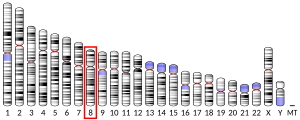CNGB3
Izgled
Ciklični nukleotidno usidreni kanal beta 3, znan i kao CNGB3, je ljudski gen koji kodira preotein ionskog kanala.[5]
Aminokiselinska sekvenca
[uredi | uredi izvor]Dužina polipeptidnog lanca je 809 aminokiselina, а molekulska težina 92.167 Da.[6]
| 10 | 20 | 30 | 40 | 50 | ||||
|---|---|---|---|---|---|---|---|---|
| MFKSLTKVNK | VKPIGENNEN | EQSSRRNEEG | SHPSNQSQQT | TAQEENKGEE | ||||
| KSLKTKSTPV | TSEEPHTNIQ | DKLSKKNSSG | DLTTNPDPQN | AAEPTGTVPE | ||||
| QKEMDPGKEG | PNSPQNKPPA | APVINEYADA | QLHNLVKRMR | QRTALYKKKL | ||||
| VEGDLSSPEA | SPQTAKPTAV | PPVKESDDKP | TEHYYRLLWF | KVKKMPLTEY | ||||
| LKRIKLPNSI | DSYTDRLYLL | WLLLVTLAYN | WNCCFIPLRL | VFPYQTADNI | ||||
| HYWLIADIIC | DIIYLYDMLF | IQPRLQFVRG | GDIIVDSNEL | RKHYRTSTKF | ||||
| QLDVASIIPF | DICYLFFGFN | PMFRANRMLK | YTSFFEFNHH | LESIMDKAYI | ||||
| YRVIRTTGYL | LFILHINACV | YYWASNYEGI | GTTRWVYDGE | GNEYLRCYYW | ||||
| AVRTLITIGG | LPEPQTLFEI | VFQLLNFFSG | VFVFSSLIGQ | MRDVIGAATA | ||||
| NQNYFRACMD | DTIAYMNNYS | IPKLVQKRVR | TWYEYTWDSQ | RMLDESDLLK | ||||
| TLPTTVQLAL | AIDVNFSIIS | KVDLFKGCDT | QMIYDMLLRL | KSVLYLPGDF | ||||
| VCKKGEIGKE | MYIIKHGEVQ | VLGGPDGTKV | LVTLKAGSVF | GEISLLAAGG | ||||
| GNRRTANVVA | HGFANLLTLD | KKTLQEILVH | YPDSERILMK | KARVLLKQKA | ||||
| KTAEATPPRK | DLALLFPPKE | ETPKLFKTLL | GGTGKASLAR | LLKLKREQAA | ||||
| QKKENSEGGE | EEGKENEDKQ | KENEDKQKEN | EDKGKENEDK | DKGREPEEKP | ||||
| LDRPECTASP | IAVEEEPHSV | RRTVLPRGTS | RQSLIISMAP | SAEGGEEVLT | ||||
| IEVKEKAKQ |
Također pogledajte
[uredi | uredi izvor]Reference
[uredi | uredi izvor]- ^ a b c GRCh38: Ensembl release 89: ENSG00000170289 - Ensembl, maj 2017
- ^ a b c GRCm38: Ensembl release 89: ENSMUSG00000056494 - Ensembl, maj 2017
- ^ "Human PubMed Reference:". National Center for Biotechnology Information, U.S. National Library of Medicine.
- ^ "Mouse PubMed Reference:". National Center for Biotechnology Information, U.S. National Library of Medicine.
- ^ "Entrez Gene: CNGB3 cyclic nucleotide gated channel beta 3".
- ^ "UniProt, Q9NQW8" (jezik: engleski). Pristupljeno 15. 9. 2021.
Dopunska literatura
[uredi | uredi izvor]- Hofmann F, Biel M, Kaupp UB (2006). "International Union of Pharmacology. LI. Nomenclature and structure-function relationships of cyclic nucleotide-regulated channels". Pharmacol. Rev. 57 (4): 455–62. doi:10.1124/pr.57.4.8. PMID 16382102. S2CID 45853869.
- Koenekoop RK, Lopez I, den Hollander AI, et al. (2007). "Genetic testing for retinal dystrophies and dysfunctions: benefits, dilemmas and solutions". Clin. Experiment. Ophthalmol. 35 (5): 473–85. doi:10.1111/j.1442-9071.2007.01534.x. PMID 17651254. S2CID 37487873.
- Pentao L, Lewis RA, Ledbetter DH, et al. (1992). "Maternal uniparental isodisomy of chromosome 14: association with autosomal recessive rod monochromacy". Am. J. Hum. Genet. 50 (4): 690–9. PMC 1682625. PMID 1347967.
- Winick JD, Blundell ML, Galke BL, et al. (1999). "Homozygosity mapping of the Achromatopsia locus in the Pingelapese". Am. J. Hum. Genet. 64 (6): 1679–85. doi:10.1086/302423. PMC 1377911. PMID 10330355.
- Sundin OH, Yang JM, Li Y, et al. (2000). "Genetic basis of total colourblindness among the Pingelapese islanders". Nat. Genet. 25 (3): 289–93. doi:10.1038/77162. PMID 10888875. S2CID 22948732.
- Kohl S, Baumann B, Broghammer M, et al. (2000). "Mutations in the CNGB3 gene encoding the beta-subunit of the cone photoreceptor cGMP-gated channel are responsible for achromatopsia (ACHM3) linked to chromosome 8q21". Hum. Mol. Genet. 9 (14): 2107–16. doi:10.1093/hmg/9.14.2107. PMID 10958649.
- Peng C, Rich ED, Thor CA, Varnum MD (2003). "Functionally important calmodulin-binding sites in both NH2- and COOH-terminal regions of the cone photoreceptor cyclic nucleotide-gated channel CNGB3 subunit". J. Biol. Chem. 278 (27): 24617–23. doi:10.1074/jbc.M301699200. PMID 12730238.
- Peng C, Rich ED, Varnum MD (2003). "Achromatopsia-associated mutation in the human cone photoreceptor cyclic nucleotide-gated channel CNGB3 subunit alters the ligand sensitivity and pore properties of heteromeric channels". J. Biol. Chem. 278 (36): 34533–40. doi:10.1074/jbc.M305102200. PMID 12815043.
- Johnson S, Michaelides M, Aligianis IA, et al. (2004). "Achromatopsia caused by novel mutations in both CNGA3 and CNGB3". J. Med. Genet. 41 (2): 20e–20. doi:10.1136/jmg.2003.011437. PMC 1735666. PMID 14757870.
- Peng C, Rich ED, Varnum MD (2004). "Subunit configuration of heteromeric cone cyclic nucleotide-gated channels". Neuron. 42 (3): 401–10. doi:10.1016/S0896-6273(04)00225-9. PMID 15134637. S2CID 16989789.
- Michaelides M, Aligianis IA, Ainsworth JR, et al. (2004). "Progressive cone dystrophy associated with mutation in CNGB3". Invest. Ophthalmol. Vis. Sci. 45 (6): 1975–82. doi:10.1167/iovs.03-0898. PMID 15161866.
- Okada A, Ueyama H, Toyoda F, et al. (2004). "Functional role of hCngb3 in regulation of human cone cng channel: effect of rod monochromacy-associated mutations in hCNGB3 on channel function". Invest. Ophthalmol. Vis. Sci. 45 (7): 2324–32. doi:10.1167/iovs.03-1094. PMID 15223812.
- Kohl S, Varsanyi B, Antunes GA, et al. (2005). "CNGB3 mutations account for 50% of all cases with autosomal recessive achromatopsia". Eur. J. Hum. Genet. 13 (3): 302–8. doi:10.1038/sj.ejhg.5201269. PMID 15657609.
- Nishiguchi KM, Sandberg MA, Gorji N, et al. (2006). "Cone cGMP-gated channel mutations and clinical findings in patients with achromatopsia, macular degeneration, and other hereditary cone diseases". Hum. Mutat. 25 (3): 248–58. doi:10.1002/humu.20142. PMID 15712225. S2CID 10889075.
- Varsányi B, Wissinger B, Kohl S, et al. (2006). "Clinical and genetic features of Hungarian achromatopsia patients". Mol. Vis. 11: 996–1001. PMID 16319819.
- Bright SR, Brown TE, Varnum MD (2006). "Disease-associated mutations in CNGB3 produce gain of function alterations in cone cyclic nucleotide-gated channels". Mol. Vis. 11: 1141–50. PMID 16379026.
- Bright SR, Rich ED, Varnum MD (2007). "Regulation of human cone cyclic nucleotide-gated channels by endogenous phospholipids and exogenously applied phosphatidylinositol 3,4,5-trisphosphate". Mol. Pharmacol. 71 (1): 176–83. doi:10.1124/mol.106.026401. PMID 17018579. S2CID 25496962.
- Wiszniewski W, Lewis RA, Lupski JR (2007). "Achromatopsia: the CNGB3 p.T383fsX mutation results from a founder effect and is responsible for the visual phenotype in the original report of uniparental disomy 14". Hum. Genet. 121 (3–4): 433–9. doi:10.1007/s00439-006-0314-y. PMID 17265047. S2CID 7955648.
Vanjski linkovi
[uredi | uredi izvor]- GeneReviews/NIH/NCBI/UW entry on Achromatopsia
- OMIM entries on Achromatopsia
- CNGB3 protein, human na US National Library of Medicine Medical Subject Headings (MeSH)




